DRY AGED BEEF
Although Dry-Aged Beef is very much the “trendy meat” at present,
it is not a new invention. On the contrary, this process has a tradition
dating back centuries.
Here you get all information and expert tips!
Dry-aged beef production also used to be referred to simply as “hanging meat”. This is because after slaughtering the sides of beef are first allowed to dangle freely in the air, well chilled at temperatures of around freezing point. This allows liquid to escape and vital enzymes to quietly do their work. This produces a delicate, full-flavoured dry-aged meat that is very popular not just with steak connoisseurs.
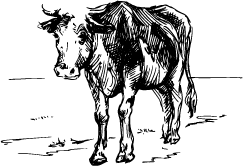
But dry-aged beef production has two small drawbacks: It is time-consuming and entails a loss of volume of up to 30% – but not in the DRY AGER®. In this fridge, the pure weight loss resulting from liquid escaping after four weeks of aging on the bone is only around 7 to 8%, so more of the meat is retained. Before the DRY AGER® existed, the advent of vacuum machines and the higher weight loss during dry aging meant that many businesses opted to switch to wet aging in a bag. At the time, the method seemed to be more reliable, faster and still less expensive. As the slow-food movement has developed in the 21st century, this process has happily been rediscovered and championed again. Dry-aged beef is now even available to buy in the supermarket.

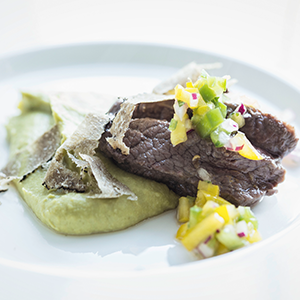
In this case, the trend towards dry-aged meat is a real boost for flavour and quality. This is because to achieve a good result a good product must also be employed in dry-aged beef production. When it comes to sourcing animals, professional chefs and master-butchers therefore prefer breeds of cattle that grow at a slower rate. The slower growth of the muscle flesh gives it a fine fat-marbled effect. This is vital for the resulting flavour. Even if the dry-aged beef is allowed to age at rest, the meat should come from younger animals. Ideally from the heifer, a young, female cow which has not yet calved but is already fully grown. But pork, lamb and game are also suitable for dry aging – give it a try!
The butcher’s trade in the modern age enjoys many better technical conditions. One of the major concerns for master-butchers back in history therefore no longer arises. If there were temperature fluctuations, this could cause rotting of the bone marrow which then spoiled the entire piece of meat. In today’s high-tech industrial maturing chambers, constant temperatures of from one to three degrees Celsius must prevail. The humidity is also very precisely controlled. In addition, optimum ventilation is required. Under these conditions, the juicy beef is transformed when it is dried for between 21 and 42 days into tasty dry-aged beef. The hung meat forms a dark crust under which the soft muscular meat does its work. The crust is as black as black pudding and hard, and a white fuzz of harmless mould can even form over it. If the dry-aged meat is aged for long enough, the crust is separated from it. The meat juice evaporates and leaves behind a delicately tender, dark meat with the typical flavours of nut and butter that make the hearts of true connoisseurs beat a little faster.
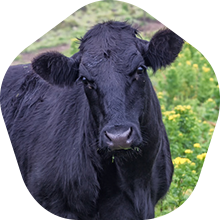
ANGUS
Black Angus cattle can be recognized immediately on the monochrome black fur and a small bump on the hornless head. Angus is one of the world’s most popular meat cattle breeders, because the animals are premature, grow fast and guarantee incredibly delicious meat. They also manage well with different fodder species. We mainly buy our Black Angus from the USA, Ireland and Argentina. There the animals can be used all year round
Free sky.
***
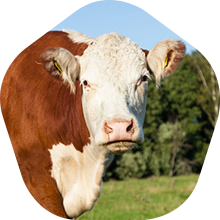
HEREFORD
The Hereford cattle comes from Herefordshire in England, Great Britain, where it was bred already in the 17th century. From the original workmate, the Hereford became a meat bode because the attitude is unpretentious, adaptable and climatological. It is the world’s most popular meat cattle breed: North and South America (Argentina, Brazil, Uruguay), Australia, New Zealand, South Africa.
***
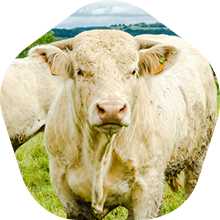
CHAROLAIS
The French breed “Charolais” is known to connoisseurs all over the world for its special meat quality, since the French breeders have always distinguished strictly between milk and meat grind breeds and “charolais” are almost exclusively cultivated for meat production. The
Meat is distinguished by the fact that it is particularly lean and has hardly any intramuscular fat deposits.
***
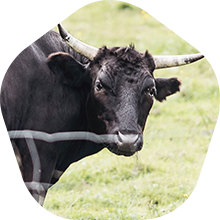
WAGYU
Japan is home to the Wagyu cattle. For centuries the breeding of the cattle was firmly in the Japanese hand. Even today the breeders benefit from the long experience in the breeding and slaughter of the noble domestic cattle. Wagyu cattle are kept in extremely small groups. Breeders specializing in Kobe meat may even hold a maximum of 34 animals at the same time.
***

When an animal dies and the metabolism wanes, there is a deficiency of adenosine triphosphate, or ATP for short, in the muscles. Without ATP the muscle proteins remain in a rigid coupling. Only after a little time is there a release of the glycogen which, as a carbohydrate compound, is regarded as an energy reserve. The glycogen is converted into lactic acid with the aid of oxygen. This in turn activates the protease enzymes which then ultimately break up the rigid coupling. This produces a soft, delicate muscular meat. This process takes place with both dry-aged beef production and with wet aging in a vacuum. However, in the case of aging in a vacuum bag, the meat juice which escapes cannot evaporate. It also contains the lactic acid bacteria that produce a slightly metallic taste. By contrast, the escaping liquid evaporates in dry-aged beef production. This ensures that salt and fat proteins which enhance the flavour are dominant.

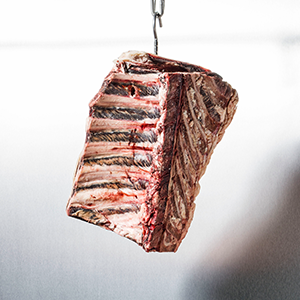
The time-consuming dry-aged beef production, the excellent quality of the meat and the loss of weight from the cut are reflected in the price of dry-aged beef. Dry-aged meat is expensive. 50 – 80 euros per kilogram is a normal market price. This is also one of the reasons why more and more catering businesses are opting to use their own maturing processes. For there is no longer any need for maturing chambers. Dry-aged meat can be produced very successfully in maturing bags or a dedicated maturing fridge – even in your own kitchen at home.

A maturing fridge such as the DRY AGER® from Landig is a worthwhile investment and delivers an unrivalled result. But if you just want to test what dry-aged beef tastes like in a private capacity, you should use the dry-aged maturing bag from Lava. In terms of flavour, this special membrane dry-aging bag also has plenty to offer. The major advantage of the maturing fridge remains its capacity. Entire loins of beef can be hung by the bone, and this enhances the flavour. The bag is only suitable for cuts, and it is also important to know that in the maturing bag the lack of a fat layer and the bone side means that there is no protective outer layer and therefore unfortunately there can be weight losses of more than 30% – so it is very evident that with larger quantities the DRY AGER® will pay for itself after just a few full loads.

The best foundation for dry-aged meat is ideally supplied by a butcher you can trust. For around 15 euros per kilo, you can get an excellent loin of meat. You can then choose your own favourite cut, from a T-bone to a fillet. But there are also trustworthy and quality-approved suppliers online. Whatever option you choose, the essential thing is always to maintain an unbroken cold chain – and ensure maximum cleanliness during processing. Gloves, a hairnet and a face mask are just as essential as clean, sharp cutting tools.

Whether you prefer rib-eye, roast beef or a fillet steak is a matter of taste. What matters is that you age the meat for the right length of time. A tender piece of sirloin requires just about a week, and a piece on the bone can easily remain in the maturing fridge for four weeks. With the dry-aged maturing bag, an aging period of 21 days generally should not be exceeded.

When the meat has a dark crust and smells slightly of yeast and ham, it is mature. The dark crust is cut off and can no longer be used. A mature dry-aged meat is apparent from the reddish-brown colour below the crust and the firmness of the meat. If you press a finger on the dry-aged beef, a depression ought to be left behind.
For 4 people:
750 grams of beef steat, 1 egg yolk, 2 shallots, pepper, Fleur de Sel, 1 pack of french fries, 1
Cucumber, 100 grams of small tomatoes, ½ head salad, some ketchup / cocktail sauce, 4 burger rolls, a little olive oil for roasting, 4 slices of mountain cheese
Preparation:
1. Mix the beef steat with the egg yolk.
2. Cut shallots very finely and with the Tatar mix.
3. Peppers, salt.
4. To form 4 equal-sized burgers.
5. Heat pan, fry the burgers medium.
6. Slice the bread roll.
7. Fry the bacon.
8. Burger rolls provided with burger patties.
9. Place the cheese and melt in the oven.
10. Add some cocktail sauce to the burger.
11. Add bacon and rolls.
12. prepare french fries according to pack instructions
13. Garnish with head salad.
14. Mix the cucumber slices with other salad, sliced tomatoes,
15. Do everything on plates and enjoy!
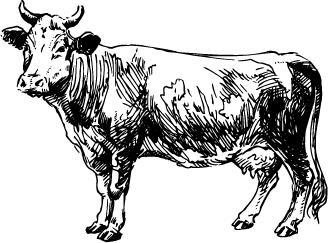
In a maturing fridge, it is very easy to control the humidity and temperature, and the air is also sterilised. This means you can directly influence the resulting taste and find out your own personal favourite flavour. The DRY AGER® is also supplied in an extremely attractive stainless steel design with a glazed front door. This means that just looking at it provides a sense of anticipation. The panes of glass in the DRY AGER® do not let any UV light through. This means that the meat is fully protected throughout dry-aged beef production.
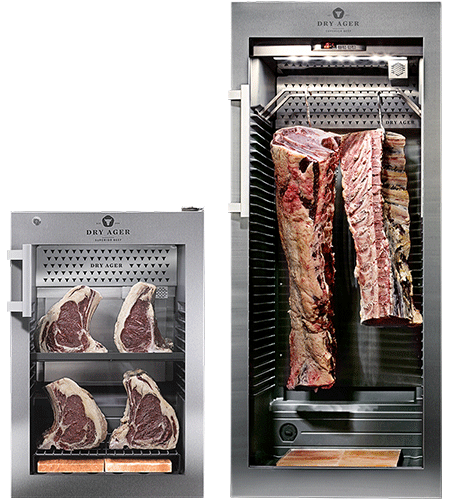
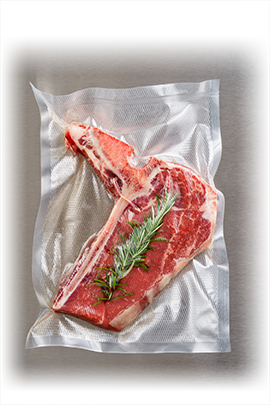
The partially transparent disposable bags can be used to mature the dry-aged meat semi-professionally in a normal refrigerator. The maturing bags are sealed with a vacuum device (tip: Lava vacuum sealer). Suitably packed, the dry-aged beef is stored in the refrigerator on a rack at around 3 degrees for 2 – 3 weeks.
Are you ready for the next level of dry aging? Our DRY AGER® catalog offers you comprehensive insights into the revolutionary technology of food refinement. Dive into the world of perfect aging! We'll show you the unprecedented taste experiences you can achieve with the DRY AGER® aging cabinets and SmartAging® technology.